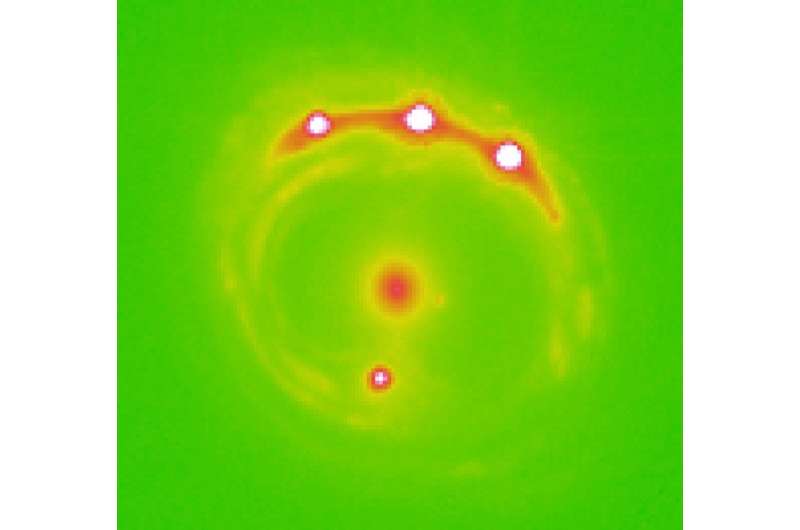Astrophysicists discover planets in extragalactic galaxies using microlensing

A University of Oklahoma astrophysics team has discovered for the first time a population of planets beyond the Milky Way galaxy. Using microlensing—an astronomical phenomenon and the only known method capable of discovering planets at truly great distances from the Earth among other detection techniques—OU researchers were able to detect objects in extragalactic galaxies that range from the mass of the Moon to the mass of Jupiter.
Xinyu Dai, professor in the Homer L. Dodge Department of Physics and Astronomy, OU College of Arts and Sciences, with OU postdoctoral researcher Eduardo Guerras, made the discovery with data from the National Aeronautics and Space Administration's Chandra X-ray Observatory, a telescope in space that is controlled by the Smithsonian Astrophysical Observatory.
"We are very excited about this discovery. This is the first time anyone has discovered planets outside our galaxy," said Dai. "These small planets are the best candidate for the signature we observed in this study using the microlensing technique. We analyzed the high frequency of the signature by modeling the data to determine the mass."
While planets are often discovered within the Milky Way using microlensing, the gravitational effect of even small objects can create high magnification leading to a signature that can be modeled and explained in extragalactic galaxies. Until this study, there has been no evidence of planets in other galaxies.
"This is an example of how powerful the techniques of analysis of extragalactic microlensing can be. This galaxy is located 3.8 billion light years away, and there is not the slightest chance of observing these planets directly, not even with the best telescope one can imagine in a science fiction scenario," said Guerras. "However, we are able to study them, unveil their presence and even have an idea of their masses. This is very cool science."
For this study, OU researchers used the NASA Chandra X-ray Observatory at the Smithsonian Astrophysical Observatory. The microlensing models were calculated at the OU Supercomputing Center for Education and Research.
A paper, "Probing Planets in Extragalactic Galaxies Using Quasar Microlensing," by Dai and Guerras on this study has been published in the Astrophysical Journal Letters.
More information: Xinyu Dai et al, Probing Planets in Extragalactic Galaxies Using Quasar Microlensing, The Astrophysical Journal (2018). DOI: 10.3847/2041-8213/aaa5fb
Abstract
Previously, planets have been detected only in the Milky Way galaxy. Here, we show that quasar microlensing provides a means to probe extragalactic planets in the lens galaxy, by studying the microlensing properties of emission close to the event horizon of the supermassive black hole of the background quasar, using the current generation telescopes. We show that a population of unbound planets between stars with masses ranging from Moon to Jupiter masses is needed to explain the frequent Fe Kα line energy shifts observed in the gravitationally lensed quasar RXJ 1131–1231 at a lens redshift of z = 0.295 or 3.8 billion lt-yr away. We constrain the planet mass-fraction to be larger than 0.0001 of the halo mass, which is equivalent to 2000 objects ranging from Moon to Jupiter mass per main-sequence star.
Journal information: Astrophysical Journal Letters , Astrophysical Journal
Provided by University of Oklahoma



















